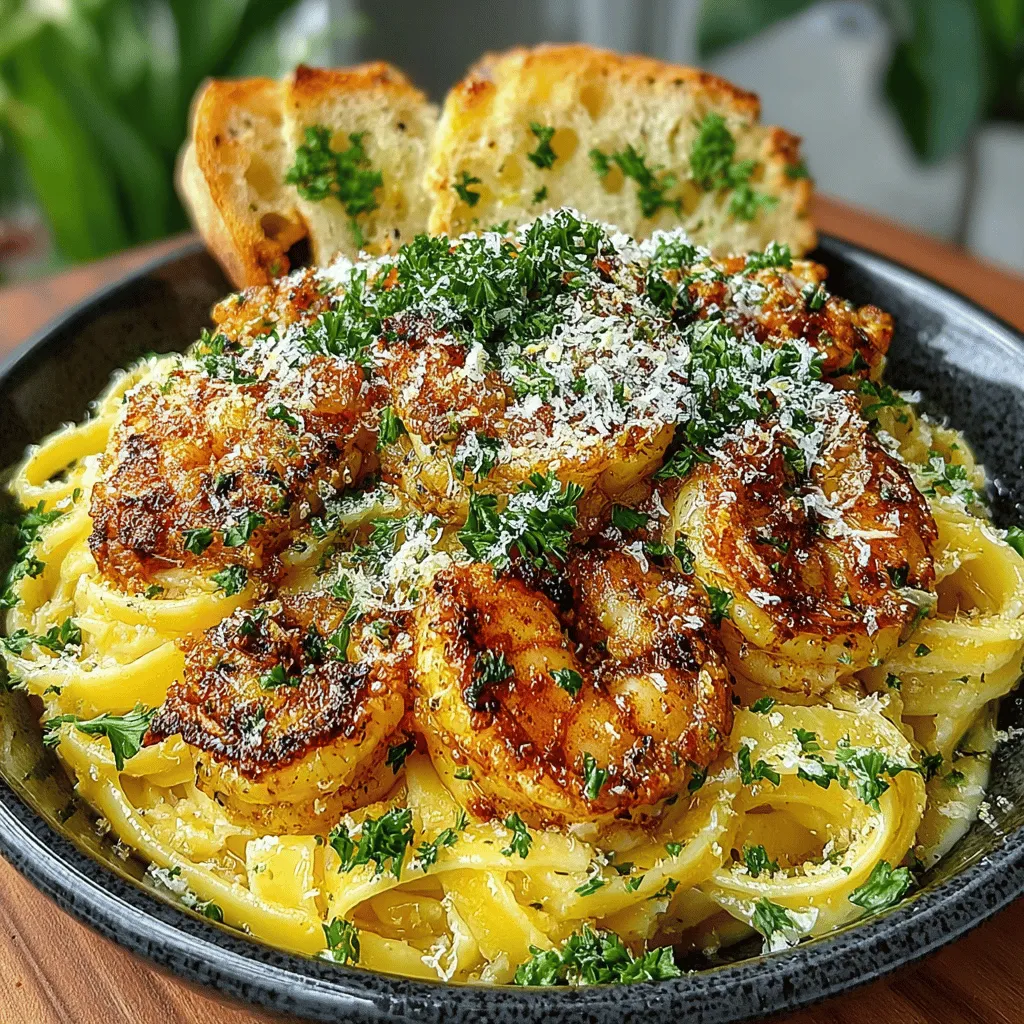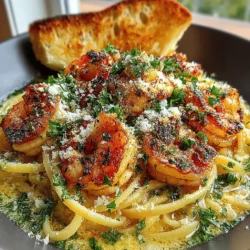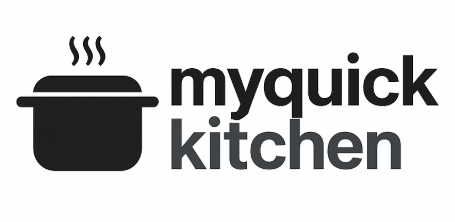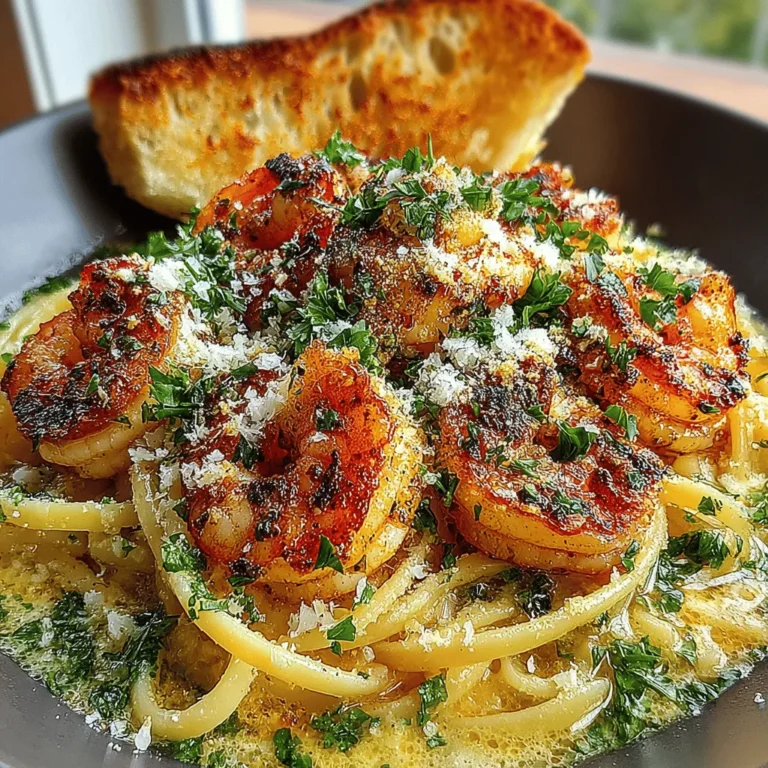Elegant Shrimp Scampi Linguine Recipe
Introduction
Shrimp Scampi is a classic Italian dish that has captured the hearts and palates of food lovers around the world. With its roots deeply embedded in Italian coastal cuisine, this delightful recipe showcases the sweetness of succulent shrimp, paired with a luscious garlic and butter sauce, all served atop a delicate bed of linguine. The appeal of Shrimp Scampi lies not only in its rich flavors but also in its ability to transform an ordinary weeknight dinner into an elegant dining experience. Whether you are hosting a cozy gathering or preparing a romantic meal for two, this dish is sure to impress.
One of the standout features of Shrimp Scampi Linguine is its simplicity. The recipe relies on fresh ingredients and straightforward cooking techniques, allowing even novice cooks to create a restaurant-quality meal at home. Each component harmonizes beautifully, culminating in a dish that is both satisfying and refined. As we delve into the nuances of this recipe, you’ll discover how to elevate your culinary skills while indulging in a meal that is as pleasing to the eye as it is to the taste buds.
Understanding Shrimp Scampi
The origins of Shrimp Scampi can be traced back to the coastal regions of Italy, where seafood is a staple of the local diet. Traditionally, “scampi” refers to a specific type of small lobster found in the Mediterranean Sea, but in American cuisine, the term has evolved to denote shrimp prepared in a similar style. The dish typically features shrimp that are sautéed in a garlic butter sauce, often enhanced with white wine, lemon, and parsley. This combination creates a wonderfully fragrant and savory sauce that clings to the pasta, making every bite a burst of flavor.
Over the years, various adaptations of Shrimp Scampi have emerged, reflecting regional preferences and personal tastes. Some may include additional ingredients like tomatoes, or even cream, to create a richer sauce. However, the foundational elements remain the same: high-quality shrimp, aromatic garlic, and a balance of acidity from lemon and wine. One of the key aspects of this dish is the choice of pasta. Linguine is often favored for its long, flat shape, which allows it to absorb the sauce more effectively than other types of pasta. The texture of linguine pairs beautifully with the tender shrimp, creating a satisfying mouthfeel that enhances the overall dining experience.
Ingredients Overview
To create a memorable Shrimp Scampi Linguine, it is essential to use fresh, high-quality ingredients. Here’s a detailed description of each component and its importance in the dish:
– Linguine Pasta: This long, flat pasta is the perfect base for Shrimp Scampi. Its shape allows it to capture the sauce, ensuring that each bite is infused with flavor. When cooked to al dente perfection, linguine provides a delightful chewiness that complements the shrimp and sauce.
– Large Shrimp: Choosing the right shrimp is crucial for optimal flavor and texture. Look for large, fresh shrimp, preferably wild-caught, as they tend to have a sweeter taste and firmer texture. When purchasing shrimp, check for a slight sheen and a fresh ocean scent.
– Unsalted Butter: The richness of unsalted butter is fundamental in creating a velvety sauce. It provides a luxurious mouthfeel and balances the saltiness of other ingredients. Using unsalted butter allows you to control the overall saltiness of the dish.
– Extra Virgin Olive Oil: This high-quality oil enhances the flavor profile of the sauce and adds healthy fats. Its fruity notes complement the shrimp and garlic, while also preventing the butter from burning during cooking.
– Garlic: An essential aromatic element, garlic infuses the dish with its distinct flavor and aroma. Freshly minced garlic is recommended for the best taste, as it releases its natural oils and flavor when sautéed.
– Red Pepper Flakes: These add a touch of heat to the dish, which can be adjusted according to personal preference. A pinch of red pepper flakes can elevate the flavors without overpowering the delicate shrimp.
– Dry White Wine: The acidity of dry white wine adds depth and brightness to the sauce. As it cooks down, it enhances the overall flavor while also helping to deglaze the pan, capturing any browned bits of shrimp and garlic.
– Lemon Juice and Zest: Fresh lemon juice and zest bring a bright, citrusy contrast to the richness of the butter and shrimp. This balance of flavors is key to a well-rounded dish.
– Fresh Parsley: Chopped fresh parsley not only adds a pop of color but also contributes a fresh, herby flavor that complements the other ingredients. It’s best to use flat-leaf parsley for its robust taste.
– Parmesan Cheese: While optional, freshly grated Parmesan cheese adds a savory, salty element to the dish. A sprinkle on top just before serving can enhance the overall flavor profile.
Step-by-Step Cooking Instructions
Cooking the Linguine
To begin your Shrimp Scampi Linguine, start by cooking the linguine. Fill a large pot with water and bring it to a rolling boil. It’s essential to generously salt the water; this is your only chance to season the pasta itself. A good rule of thumb is to use about one tablespoon of salt for every quart of water. Once the water is boiling, add the linguine and cook according to the package instructions, usually around 8-10 minutes, until the pasta is al dente.
Keep in mind that you’ll want the pasta to be firm to the bite, as it will continue to cook slightly when combined with the shrimp and sauce. Before draining the pasta, reserve about a cup of the starchy pasta water. This water will be invaluable for adjusting the consistency of your sauce later.
Sautéing the Shrimp
While the linguine is cooking, it’s time to prepare the shrimp. In a large skillet, heat a combination of unsalted butter and extra virgin olive oil over medium-high heat. The mixture of oils not only prevents burning but also adds layers of flavor. Once the butter has melted and starts to bubble, add the minced garlic, stirring constantly for about 30 seconds until fragrant. Be careful not to let the garlic brown, as it can turn bitter.
Next, add the large shrimp to the skillet in a single layer, cooking them for about 2-3 minutes on one side until they turn pink and opaque. Flip the shrimp over and add a pinch of red pepper flakes for heat. If you prefer a milder flavor, feel free to adjust this amount or omit it entirely. After flipping, pour in the dry white wine, allowing the mixture to simmer for an additional 2-3 minutes. This will enable the alcohol to cook off while the flavors meld together beautifully.
As the shrimp cook, you’ll notice the sauce beginning to thicken and take on a lovely golden hue. After the shrimp are fully cooked, remove the skillet from the heat and prepare to combine the pasta and sauce in the next step, ensuring that every aspect of your dish is infused with flavor.
Keep the excitement brewing as you continue to the next steps of this elegant culinary creation!

Techniques for Achieving Perfectly Cooked Shrimp
Cooking shrimp to perfection is all about timing and technique. The key is to ensure that each shrimp is cooked just until it turns opaque and has a slight curl, which typically takes about 2-3 minutes per side. To achieve this, use medium-high heat and avoid overcrowding the pan, as this can lead to steaming rather than searing.
1. Choosing Fresh Shrimp: When selecting shrimp, look for those that are firm to the touch and have a mild, ocean-like smell. Fresh shrimp tend to have a slight sheen and should be translucent. If using frozen shrimp, make sure to thaw them properly in the refrigerator before cooking.
2. Marinating: For added flavor, consider marinating the shrimp in a mixture of olive oil, garlic, and lemon juice for 15-30 minutes before cooking. This not only infuses the shrimp with flavor but also helps to tenderize them.
3. Cooking in Batches: If you have a large batch of shrimp, cook them in batches to maintain the pan’s temperature. This will ensure that they sear properly, developing a nice golden crust.
The Significance of Garlic and Red Pepper Flakes in Flavor Development
Garlic and red pepper flakes are essential components of shrimp scampi linguine, as they contribute significantly to the dish’s depth of flavor.
– Garlic: Fresh garlic should be sautéed until fragrant but not browned. Overcooked garlic can become bitter, so add it to the pan just before the shrimp to maximize its aromatic qualities. The garlic releases its oils into the dish, creating a rich base that complements the shrimp beautifully.
– Red Pepper Flakes: These add a subtle heat that balances the dish. Depending on your heat preference, you can adjust the amount. Start with a pinch, and add more if desired, tasting as you go.
Deglazing the Pan
Deglazing is a crucial step in building layers of flavor in your shrimp scampi linguine.
The Purpose of This Step
After cooking the shrimp, you’ll notice brown bits stuck to the bottom of the pan—these are packed with flavor. Deglazing involves adding liquid to the hot pan to loosen these bits, enriching your sauce.
Tips for Selecting the Right Wine for Deglazing
When choosing a wine for deglazing, opt for a dry white wine such as Pinot Grigio or Sauvignon Blanc. These wines add acidity that enhances the flavors without overpowering the dish. Avoid sweet wines, as they can alter the intended flavor profile.
– Wine Selection: Look for a wine that you enjoy drinking, as the flavors will concentrate in the dish.
Combining Ingredients
Integrating the pasta with the shrimp and sauce is where the magic happens.
1. Draining Pasta: Once your linguine is al dente, reserve about a cup of pasta water before draining. This starchy water can be used to adjust the sauce’s consistency later.
2. Creating the Sauce: After deglazing the pan and allowing the wine to reduce slightly, add the drained linguine directly to the pan with the shrimp. Toss the pasta gently in the sauce, ensuring every strand is coated evenly.
3. Adjusting Sauce Consistency: If the sauce seems too thick, gradually add reserved pasta water until you reach your desired consistency. The starchy water not only helps in binding the sauce to the pasta but also enhances the overall flavor.
Finishing Touches
The final steps are essential for creating a dish that is both visually appealing and delicious.
1. Butter and Olive Oil: Adding a pat of butter along with a drizzle of high-quality olive oil at the end creates a glossy finish and adds richness to the dish. Stir these in off the heat to prevent the butter from separating.
2. Final Seasoning Adjustments: Taste your dish before serving. You may want to adjust the seasoning with additional salt, pepper, or even a squeeze of fresh lemon juice to brighten the flavors.
Plating and Presentation
Plating your shrimp scampi linguine elegantly can elevate the dining experience.
1. Dish Choice: Use wide, shallow bowls to showcase the pasta. Twirling the linguine into a nest shape adds height and visual interest.
2. Garnishing: Finish with a sprinkle of freshly chopped parsley for a pop of color and a light dusting of grated Parmesan cheese for extra flavor. A lemon wedge on the side not only adds color but allows diners to customize the acidity to their taste.
3. Serving Accompaniments: Pair your dish with crusty bread for dipping in the sauce, or serve alongside a fresh salad to balance the richness of the pasta.
Pairing Suggestions
To enhance your dining experience, consider these pairing suggestions:
1. Recommended Wine Pairings: A chilled glass of Pinot Grigio or a crisp Sauvignon Blanc complements the dish’s flavors beautifully, balancing the richness of the shrimp scampi.
2. Side Dishes: Garlic bread is a classic side that pairs wonderfully with shrimp scampi, allowing you to savor every drop of the delicious sauce. A light, refreshing salad with a vinaigrette can also provide a nice contrast to the richness of the pasta.
Nutritional Insights
Understanding the nutritional benefits of shrimp scampi linguine can help you enjoy it as a balanced meal.
– Nutritional Benefits: Shrimp are a great source of lean protein, containing essential nutrients like omega-3 fatty acids, vitamin B12, and selenium. Linguine adds carbohydrates for energy, while garlic and olive oil provide healthy fats and antioxidants.
– Portion Control and Balance: While shrimp scampi can be indulgent, serving it alongside a salad or veggies can help create a well-rounded meal. Monitor portion sizes to maintain balance without sacrificing enjoyment.
Conclusion
Shrimp scampi linguine is a perfect dish that showcases elegance and simplicity. With its rich flavors and enticing aromas, it’s sure to impress anyone at your dinner table. The combination of perfectly cooked shrimp, aromatic garlic, and a luscious sauce makes this dish a go-to for both casual dinners and special occasions.
We encourage you to try this recipe at home and experience the delightful flavors yourself. Not only is it an impressive meal to serve guests, but it also serves as a versatile addition to any home cook’s repertoire. With just a few ingredients and steps, you can create a restaurant-quality dish that brings the taste of Italy to your kitchen. Enjoy the process, and remember—cooking is all about love and sharing delicious moments with those you cherish.


